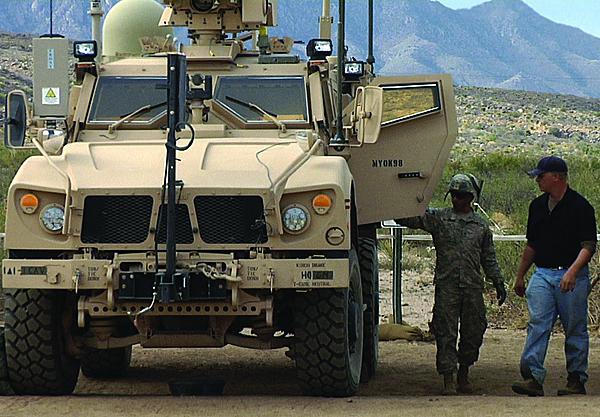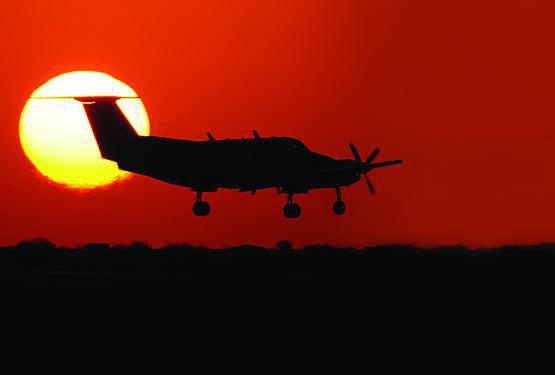One Small Step Toward Greater Interoperability
An upcoming demonstration could lead to a giant leap in common electromagnetic components.
U.S. Army researchers intend to demonstrate in the coming weeks that some components, such as antennas and amplifiers, can perform two functions—communications and electronic warfare. The ultimate goal is to use the same components for multiple purposes while dramatically reducing size, weight, power consumption and costs. The effort could lead to a set of common components for electromagnetic systems across the Army, the other military services and even international partners, which would be a boon for battlefield interoperability.
Researchers at the Army’s Communications-Electronics Research, Development and Engineering Center (CERDEC), Aberdeen Proving Ground, Maryland, are discussing the concept with personnel from a wide range of organizations, including the Army Research Laboratory, the Defense Advanced Research Projects Agency, Navy and Air Force research laboratories, universities and other countries. The idea is for common components for command, control, communications, computers, intelligence, surveillance and reconnaissance (C4ISR) to serve multiple functions, such as communications and electronic warfare, possibly switching from one function to the other or even conducting multiple missions simultaneously.
“We work with a number of international partners—NATO of course,” points out Paul Zablocky, senior research scientist for electronic warfare within CERDEC’s Intelligence and Information Warfare Directorate. “The other one is The Technical Cooperation Program, which is called TTCP. That particular organization covers the United Kingdom, Australia, New Zealand, Canada and the United States.”
The TTCP is rooted in a 1957 agreement between the United States and Great Britain with Canada and others joining later. The international organization collaborates on defense scientific and technical information exchange; program harmonization and alignment; and shared research activities. “Those organizations are great places to look at and share common interface specifications, which enables us to share equipment,” Zablocky says. “We’ve had discussions about this concept of common hardware and software for C4ISR and electronic warfare systems. I certainly envision in the future working with them on this concept.”
Still, he hesitates to overhype the possibilities. “I’m not saying that’s a definite,” he cautions, “But it is certainly a potential, and it has cost benefits for all of us.” Common C4ISR components will reduce the size, weight and power (SWAP) of electronics, saving space on air and ground platforms, lightening the load for dismounted soldiers and saving money through reduced power consumption and streamlined logistics. “It’s a hot item across the Army for multiple reasons. SWAP is a major challenge for all of the platforms in the Army,” says Seth Spoenlein, associate director for systems engineering within the CERDEC Space and Terrestrial Communications Directorate.
A demonstration referred to as the Tactical Electronic Warfare Cyber Demonstrator is scheduled for May at Yuma Proving Ground, Arizona. It will serve as a technology demonstrator for offensive electronic attack, defensive electronic attack, electronic protection, electronic support and electronic warfare-enabled cyber on ground and air platforms. The demonstration will help the Army assess technologies and capabilities for future electronic warfare. “This is step one in getting to the end-state. This is an effort to look at common hardware and software components and deliver electronic warfare, communications and position, navigation and timing capabilities. We would like to do that across the entire C4ISR set of capabilities as the end goal where we could share as much hardware and software as possible,” Spoenlein says.
CERDEC officials also describe the event as part demonstration, part experimentation. It is designed to illustrate what is possible regarding component sharing. Industry personnel also will participate, and senior Army leaders, program managers and program executive officers have been invited to attend. “It’s more than a demo,” Zablocky explains. “It’s an experiment that we’re going to do to show how much we can save in size, weight, power and cost. If all of that is successful, then our next step is to look further back into the radio, for example, and start looking at some of the digital components that could be shared.
“We will continue to work our way back and do demonstrations. Probably in a year or so we can look at sharing some of the digital aspects of these systems,” he says.
The May demonstration will involve commercially available components mounted onto ground and air platforms. “The amplifiers and antennas are already mature. What needs to be matured is how you share those across an electronic warfare system and a communications system,” Zablocky notes.
Additional research and development is needed to ensure the components will pull double duty. “Some of it may be in the software implementation where you have to coordinate the activities of the two systems through the software,” Spoenlein says. “There is some radio frequency switching that has to be done, which can also be done with software. The integration and bringing the components together is where the secret sauce is.”
Having components share signal processing is only part of the challenge. Sharing without adversely affecting performance is vital. “If you want to look at how we’re going to measure success, that would be the way we would measure it,” Zablocky notes.
Another challenge, Spoenlein states, is creating an open architecture and design so that the Army can incorporate new technologies and get the latest and greatest to the warfighters.
CERDEC officials envision using common components across platform types. For example, C4ISR systems on different kinds of aircraft could use the same components, as could various ground vehicles. More difficult, but within the realm of possibilities, is developing components that can be used across multiple platform types. Aircraft and tactical trucks, for example, could use the same components. It may even be feasible that dismounted soldiers someday could use cards or blade computers—an entire computer on a circuit card—to provide the same capabilities found on vehicles and aircraft. While soldiers would not carry the same radios or even the same antennas and amplifiers that are mounted onto ground vehicles or aircraft, the possibility exists that they could insert common cards or blades once this capability is developed.
Spoenlein uses a personal computer analogy, saying no one would want a soldier carrying a desktop computer around the battlefield. “But you may want to use the same card or blade that plugs into the computer for the soldier that you would for the vehicle or for an airborne platform,” he explains. “You might have to have different designs depending on the platform, but ideally, you would like to find as much commonality as possible.”
CERDEC officials say they will need help from industry to bring the vision to life. “What we want is to have multiple vendors develop cards, and to do that they will need to understand how the cards talk to the backplane and to each other. That all has to be specified,” Zablocky states. “That way, vendors can develop products or rapidly evolve products for us in the future. That’s where the big challenge is for us, in pulling all that together—blades, cards, the typical digital signal processing capability that we need to implement radio and electronic warfare systems and other C4ISR systems.”
Spoenlein reveals that the team is putting its vision into writing and should complete the process in the coming months. “We have a road map that we’re developing to get us to this common hardware and software. It will be a series of research and development efforts that bring us into this common solution for C4ISR capabilities,” he says.
It is too early to project cost savings, but officials say they should be significant. “Let’s just take electronic warfare and comms for example—you could get to a point where you could have one set of hardware instead of two sets of hardware on the vehicle. Each configuration on the vehicle across the fleet is rather costly. If we can bring this down so that the size, weight and power configurations are reduced, there’s a significant dollar amount that will be cost savings for the Army,” Zablocky maintains.
Furthermore, it will be easier and less expensive to upgrade systems using common components. “If we get to this concept where we have cards or blades with standard open interfaces, we can just replace the card or blade, leaving the backplane the same,” Spoenlein adds. “That in itself is a major cost savings so that the integration doesn’t have to be performed back at the depot or demand whole new requirements. The cost savings could be huge.”
Once the concept is proven, CERDEC officials intend to work with program managers to ensure common C4ISR components are considered early in the development of future platforms. “It is a paradigm shift in how we do business,” Zablocky offers. “It is a major change not only in the development but also in the fielding and integration, so there will be a lot of players that this will touch. But first, we have to prove what can be shared.”






Comments